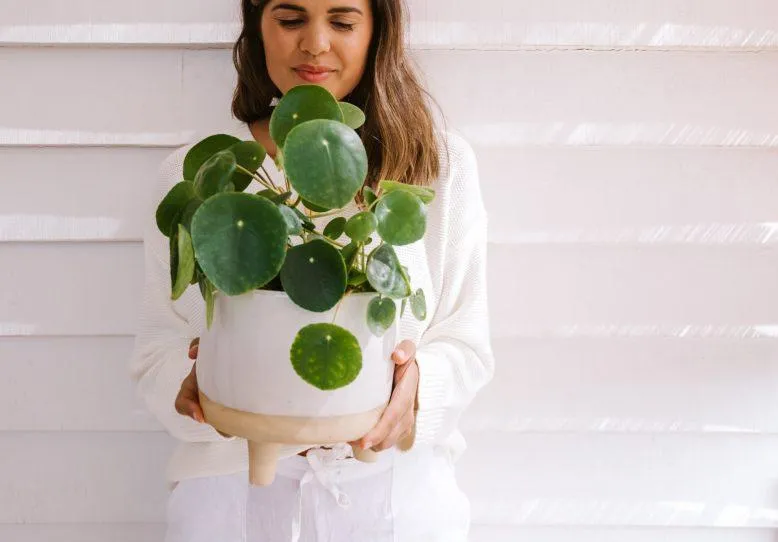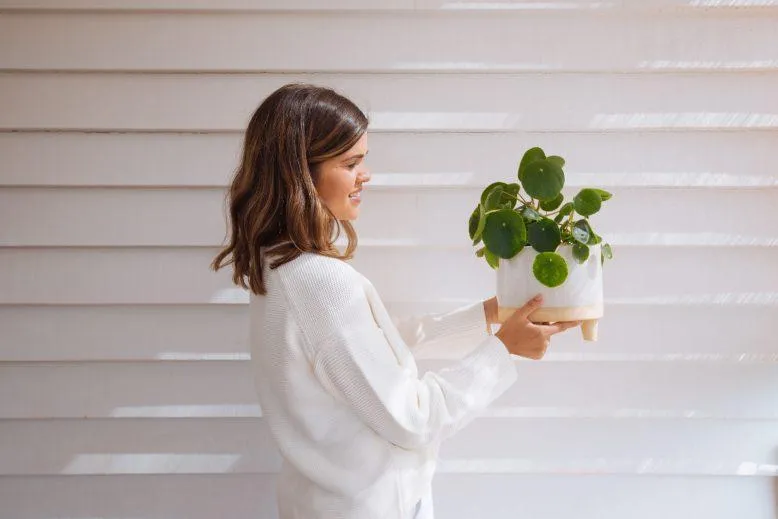A Guide to Keeping Your Pilea Peperomioides Happy with Wick Watering
One of the trendiest houseplants around lately is the Chinese Money Plant or Pilea Peperomioides. With its cute round leaves and easy care, it’s no wonder this little plant is so popular. But just watering from the top can be tricky to keep the soil evenly moist. Many pilea parents find wick watering helps them avoid overwatering issues. So in this article, I’ll cover everything you need to know about using a wick system to care for your pilea peperomioides.
Why Wick Water Your Pilea?
- Prevents Overwatering – It’s so easy to overwater pilea from the top and end up with soggy, unhappy roots. A wick allows the plant to drink only what it needs.
- More Consistent Moisture – The wick ensures the entire soil mass stays evenly moistened rather than drying out in spots.
- Less Mess – No more water splashing everywhere when you water from the top! Wicking is a neat, clean way to care for your plant.
Basically, wick watering takes the guesswork out of pilea care. It’s kind of a set-it-and-forget-it system so you don’t have to stress about getting the watering just right. The plant sucks up moisture as it needs it through the wick.
Setting Up the Wick System
You’ll need a few simple supplies to get a wick system going:
- A glass container – Any clear container will work as a reservoir, but a glass jar or vase looks nice.
- Cotton rope or synthetic fiber rope – This acts as the wick to transport water.
- Pot with drainage holes – Your pilea’s regular nursery pot.
To set it up, place some rocks or pebbles in the bottom of the glass container for the pot to sit on. This creates an air gap so the soil isn’t sitting in water.
Cut the rope wick to hang about an inch below the drainage holes. Use a chopstick or skewer to thread the wick down through the drainage holes so it rests in the water reservoir.
Fill the pot with well-draining potting mix and plant your pilea. Cut excess wick so only an inch or two hangs in the water. Top off the reservoir as needed.

Some folks add a layer of pebbles or gravel to the pot’s soil surface for aesthetics. Just be sure the wick end isn’t blocked. And there you have it – a simple self-watering system!
From my experience, synthetic wicks like plastic aquarium air line tubing work even better than natural fibers. They seem to wick water faster with less risk of mold. But kinda old school cotton rope looks cute too. Basically go with what floats your boat, pilea style.
Maintaining the Wick System
Once set up, wick watering is low maintenance. Basically just top off the reservoir when it gets low – usually every 5-7 days. Check that the wick stays immersed so it can absorb water effectively.
You may rarely need to flush the soil if mineral deposits start to form. Remove your pilea, pop it in the shower, then return it to a refreshed reservoir. No biggie.
Sort of just use your judgment – if the plant seems thirsty between refills, top up more often. If it’s still happy after 7 days, you’re good! The goal is to prevent both underwatering and overwatering – wicking finds that sweet spot.
As the seasons change, adjust how frequently you refill based on temperature and light. Pileas may need a drink more often in the dry winter air compared to the humid summer months. Pay attention to when the soil starts to dry out.

An important reminder – never let the reservoir completely run dry. The wick needs to stay hydrated to effectively transport water upwards. Keeping a close eye prevents your little pilea pal from getting parched. Wick systems aren’t foolproof, but they’re quite reliable with some minimal TLC.
Troubleshooting Wicking Issues
Sometimes wicks run into a few snags that can cause the system to stop functioning properly. Here are some common pilea wick problems and solutions:
- Wick dries out – Check it regularly and refill reservoir before it runs empty.
- Wick molded – Synthetic fibers like vinyl tubing reduce mold risk. Wash cotton wicks with diluted hydrogen peroxide or replace.
- Not wicking fast enough – Try thicker wicks, ensuring ends are submerged, adding gravel to improve contact.
- Mineral deposit buildup – Flush soil and wick periodically using distilled water.
- Roots going circular – Check pot isn’t too small, rotate periodically if needed.
With a little TLC, wicking problems are usually pretty easy to figure out. They rarely spell doom for your pilea pal. Sometimes switching up wick materials can solve stubborn issues. But I’ve found the factory setting usually works great if maintained well.
So in summary dudes, wick watering is a slam dunk way to care for your Chinese money tree. It takes the sweat out of keeping that cute soil moist while dodging root rot. Pair it with a nice spot with plenty of light, and your pilea will be thriving for years, believe! Let me know if you have any other questions.
Pilea peperomioides Care Tips
| Watering | Soil | Light | Temperature | Propagation |
|---|---|---|---|---|
| Allow soil to dry out between waterings. Do not overwater. | Well-draining potting mix. Keep soil slightly moist but not wet. | Bright, indirect light. Too much direct sun can scorch leaves. | 60-80°F. Avoid drafts and cold windows. | Remove offset plants or propagate from leaf cuttings. |
| Water less in winter when plant is not growing as actively. | Can amend potting mix with perlite or sand for improved drainage. | Foliage may lose its markings if grown in too much shade. | Avoid temperatures below 50°F which can damage leaves. | Place leaf cuttings in water to develop roots before planting. |
| Check soil moisture before watering. Only water when top inch of soil is dry. | Aroid mix works well as it retains moisture while allowing excess to drain. | Prefers bright, indirect light but can tolerate low-light conditions. | Provide humidity around 50-60% for healthy foliage without issues. | Rooted cuttings or offsets can be potted into damp soil. |
| Due to thick succulent-like leaves, pilea are very tolerant of neglect and drying out. | Pot should have drainage holes to prevent root rot from overwatering. | Inspect regularly for pests like spider mites or fungal issues in low ventilation areas. | Fertilize weakly every 2-4 weeks in spring and summer during active growth. | New plants can take some time to establish before putting out additional leaves. |
FAQ
-
How much water do pilea plants need?
Pilea plants like moist soil, but you don’t want the soil to be soaked. Basically, water when the top inch of soil is dry. It’s better to water lightly but frequently than to soak the soil. Around once a week should work for most pilea.

-
What kind of light does a pilea plant like?
Pilea plants love bright, indirect sunlight. Direct sun can scorch their leaves. Sort of aim for a spot with morning sun or afternoon sun and shade in the middle of the day. They also do well in low-light areas as long as they get some natural light each day. Artificial grow lights can work too if the pilea is indoors.
-
How do you propagate a pilea plant?
Propagating pileas from leaf cuttings is super easy. Basically, just remove a healthy leaf from the mother plant and place it securely in a glass of water. Within a few weeks, you’ll start to see roots developing. Once they’re about an inch long, you can plant the new plantlet in soil. It’s a simple way to get more pilea plants!
-
What kind of soil does a pilea need?
Most pilea plants like a well-draining potting mix. The soil shouldn’t stay soggy after watering. A mix of peat moss and perlite works well. You can also use a basic houseplant potting soil. Pileas don’t like to sit in wet soil, so adding some sand or gravel to the bottom of the pot helps drainage. Otherwise, their roots may rot.
-
How do you care for a pilea peperomioides?
To keep a pilea peperomioides happy, give it plenty of light, keep the soil moist but not soggy, and fertilize during the growing season in spring and summer. Pileas are pretty low maintenance otherwise. You can trim off leggy stems to encourage bushiness. Repot if the plant gets pot bound. Proper care will give you years of enjoyment from these stunning plants!
-
Do pilea plants need fertilizer?
While pileas can survive without fertilizer, feeding them occasionally benefits the plant. Pileas like a balanced, water soluble houseplant fertilizer diluted to half the strength recommended on the label. You can fertilize during the spring and summer months when the plant is actively growing. Give it once a month at most. Fertilizer isn’t strictly necessary, but it may help the pilea put out shinier, healthier growth.
-
Are pilea trees toxic to pets?
While pilea plants are generally considered non-toxic to cats and dogs, it’s still not a good idea to let pets chew on them. The sap may cause mild irritation if eaten. It’s better to be safe and keep pileas up high or behind a pet gate. Most health issues only happen if a large amount is ingested. Still, to avoid trips to the vet, remember to pet-proof your plant collection!

-
Can pilea plant leaves be propagated in water?
As mentioned before, propagating pileas through water is super effective. Just pop a leaf cutting into a glass of water and wait. You’ll see roots start to form within a few weeks. It’s an easy way to multiply your pilea collection. Leaves have an amazing ability to grow into an whole new plant! Once the roots are an inch long, go ahead and pot up the new plantlet in soil. The leaf cutting will literally transform into an entire pilea plant. Pretty awesome, right?
